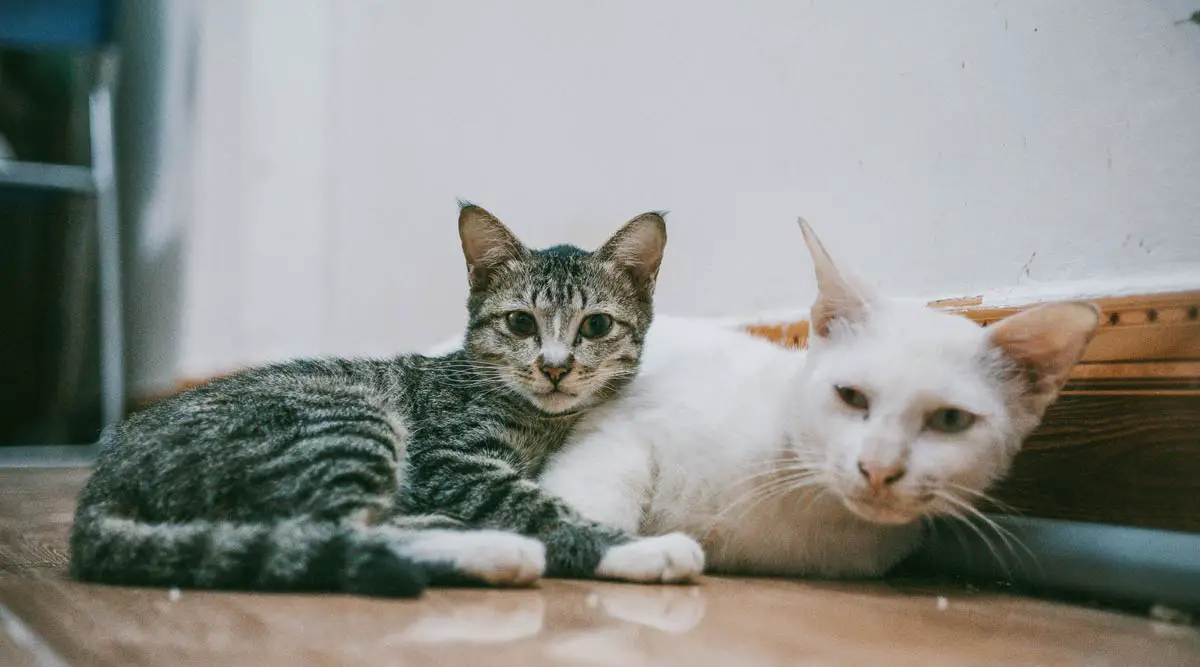Are you struggling with a cat who exhibits fear and aggression? It can be distressing to see your furry friend lash out in fear and anxiety. But don’t worry, there is hope! In this article, we will guide you through the process of training your cat to eliminate fear aggression, helping them become a calmer and happier companion.
First, it’s important to understand what fear aggression is and how it manifests in cats. By recognizing the triggers that cause your cat’s fearful behavior, you can start managing their stress effectively. Creating a safe and enriching environment is crucial for their overall well-being.
Next, we’ll explore gradual desensitization and counterconditioning techniques that can help your cat overcome their fears. Positive reinforcement training methods will also play a vital role in reshaping their behavior.
If you find yourself needing extra support, seeking professional help for behavior modification is highly recommended. Lastly, patience and consistency are key throughout the training process.
By following these steps and maintaining a fear-free lifestyle for your beloved feline friend, you can help them conquer their fear of aggression and create a stronger bond between the two of you.
- Understanding Fear Aggression in Cats
- Identifying Triggers and Managing Stress
- Creating a Safe and Enriching Environment
- Gradual Desensitization and Counterconditioning
- Positive Reinforcement Training Techniques
- Seeking Professional Help and Behavior Modification
- Patience and Consistency in Training
- Maintaining a Fear-Free Lifestyle for Your Cat
- Conclusion
Understanding Fear Aggression in Cats
Imagine a tiny cat crouching low with wide eyes and arched back, displaying fear and aggression as it hisses and swipes at anyone who dares to come near. Understanding fear aggression in cats is crucial to helping your furry friend overcome this behavior.
Feline anxiety plays a significant role in fear aggression, causing the cat to react aggressively when feeling threatened or scared. To effectively train your cat to eliminate fear aggression, you must identify the triggers that cause your pet’s aggressive response. These triggers can vary from loud noises or sudden movements to unfamiliar people or other animals invading their space. By observing your cat’s behavior closely, you can begin to recognize these triggers and work on desensitizing them.
Empathy is key when dealing with fear aggression in cats. Put yourself in their paws and try to understand how they perceive the world around them. Remember that they’re not being aggressive out of malice but rather as a defense mechanism.
With knowledge and experience, you can help your cat overcome their fear of aggression through positive reinforcement training techniques. Patience is vital during this process as progress may be slow at times. By creating a safe environment for your cat and gradually exposing them to their triggers while rewarding calm behavior, you can teach them alternative coping mechanisms.
By understanding feline anxiety and identifying aggression triggers, you’re on the right path toward training your cat to eliminate fear aggression successfully. Keep practicing empathy and patience throughout the process, knowing that with time and effort, your feline friend will become more confident and less prone to reactive behaviors.
Identifying Triggers and Managing Stress

When identifying triggers and managing stress, it’s important to recognize the situations that make your feline friend feel anxious.
Cats can exhibit fear aggression in response to specific triggers, such as loud noises, unfamiliar people or animals, or even changes in their environment. By pinpointing these triggers, you can take steps to manage your cat’s anxiety and help them feel more at ease.
One effective way to manage anxiety in cats is by gradually exposing them to their fears in a controlled manner. For example, if your cat becomes fearful around strangers, start by introducing them to one person at a time in a calm and quiet environment. Allow your cat to approach the person on their own terms while providing positive reinforcement with treats or toys. This gradual exposure can help build trust and reduce fear over time.
Another important aspect of managing stress is creating a safe space for your cat. Provide hiding spots like covered beds or boxes where they can retreat when they feel overwhelmed. Additionally, establish consistent routines and avoid sudden changes that could trigger anxiety.
Remember, every cat is unique and may respond differently to various techniques for managing fear aggression. It’s essential to be patient, and understanding, and seek professional guidance if needed. With time and effort, you can help your furry friend overcome their fears and live a happier life.
Creating a Safe and Enriching Environment
By providing a secure and stimulating environment, your feline companion can thrive and feel content in their surroundings.
Creating a safe space for your cat is crucial to help alleviate fear and aggression. Start by ensuring that your home is free from potential hazards that may cause accidents. Keep toxic substances, sharp objects, and small items out of reach. Also, make sure there aren’t any open windows or doors that could allow your cat to escape or be exposed to dangerous situations.
In addition to safety measures, it’s essential to provide mental stimulation for your cat. Cats are natural hunters and need outlets for their instincts. Engage them with interactive toys such as puzzle feeders or treat-dispensing balls that require problem-solving skills. Incorporate regular play sessions into their daily routine using various toys like feather wands or laser pointers.
Consider creating vertical spaces in your home where your cat can climb and perch comfortably. This will not only provide exercise but also give them a sense of security and control over their environment.
Establish a consistent routine for feeding, playtime, and sleep. Cats thrive on predictability and knowing what to expect can help reduce anxiety and fearfulness.
By implementing these strategies, you’ll be providing an enriching environment that promotes confidence while preventing accidents and offering much-needed mental stimulation for your feline friend’s overall well-being.
Gradual Desensitization and Counterconditioning

One effective way to help your feline companion feel more comfortable in anxiety-inducing situations is through gradual desensitization and counterconditioning techniques. These methods can be incredibly helpful in reducing fear and aggression in cats.
By slowly exposing your cat to the triggers that cause fear or anxiety, you can help them build positive associations and overcome their negative reactions.
The key to successful desensitization is taking it slow. Start by identifying the specific situations or stimuli that trigger fear aggression in your cat. Once you have identified these triggers, create a plan to gradually expose them to your cat in a controlled and safe environment. For example, if your cat becomes aggressive when meeting new people, start by having them interact with someone they trust and feel comfortable with.
As you progress with desensitization, it’s important to monitor your cat’s reactions closely. If you notice any signs of distress or aggression, take a step back and decrease the intensity of the exposure. It’s crucial not to overwhelm your cat during this process.
Counterconditioning goes hand-in-hand with desensitization. The goal is to replace negative associations with positive ones. This can be done by pairing the feared stimulus with something pleasurable for your cat, such as treats or playtime.
Remember, slow progress is key when using gradual desensitization and counterconditioning techniques. With patience and consistency, you can help your beloved feline friend overcome their fear aggression and create a safer and happier environment for both of you.
Positive Reinforcement Training Techniques
To help your feline companion feel more at ease, you can utilize positive reinforcement techniques that will build a stronger bond between you and your furry friend. Clicker training for cats is an effective method to train them without inducing fear or aggression. This technique involves using a small handheld device that makes a clicking sound when pressed. By associating the click with a reward, such as treats or praise, you can communicate to your cat what behavior you want them to perform.
Treat-based training techniques are also highly effective in eliminating fear aggression in cats. Start by finding a treat that your cat absolutely loves and use it as a reward for good behavior. Whenever your cat exhibits calm and non-aggressive behavior, give them a treat immediately after they perform the desired action. This positive reinforcement will teach your cat that good behavior results in rewards.
Remember to be patient and consistent when using these techniques. Training takes time, so don’t expect immediate results. Celebrate every small success along the way and continue reinforcing positive behaviors with treats and praise.
By utilizing clicker training and treat-based techniques, you can effectively eliminate fear aggression in your cat while strengthening the bond between you two. Your furry friend will feel more secure knowing that good behavior leads to rewards, creating a harmonious environment for both of you.
Seeking Professional Help and Behavior Modification

Seeking professional help for your feline friend’s behavior issues can provide the guidance and support needed to create a happier and more peaceful environment. When it comes to fear aggression in cats, behavioral therapy is often recommended by experts.
A professional cat behaviorist or trainer has the knowledge and experience to assess your cat’s specific needs and develop a personalized plan to address the fear of aggression. Professional guidance is essential because fear aggression can be complex and challenging to tackle on your own.
A behaviorist will first conduct a thorough assessment of your cat’s behavior, including triggers, body language, and past experiences. Based on this evaluation, they will design a customized behavior modification program that focuses on desensitization and counter-conditioning techniques.
During the training sessions, you will learn how to manage situations that trigger fear aggression in your cat while gradually exposing them to those stimuli in a controlled manner. The goal is to change their emotional response from fear or anxiety to relaxation or confidence through positive reinforcement techniques.
Remember that working with a professional does not guarantee immediate results; it requires patience and consistency from both you and your cat. However, with time and dedication, you can make significant progress in eliminating fear and aggression and creating a harmonious relationship with your furry companion.
Patience and Consistency in Training
Now that you’ve sought professional help and started implementing behavior modification techniques for your fear-aggressive cat, it’s time to focus on an essential aspect of training: patience and consistency. Building trust with your cat takes time and effort, but it’s crucial in helping them overcome their fear and aggression.
Fear aggression can be a deeply ingrained behavior, so managing your expectations is key. Understand that progress may be slow and that setbacks are normal. It’s important not to get discouraged if your cat doesn’t immediately respond to the training techniques. Remember, every small step forward is a victory.
Consistency is vital in training any animal, including cats. Establish a routine and stick to it religiously. This means following the same feeding schedule, playtime routine, and training sessions every day. By doing so, you create a sense of predictability for your cat, which can help reduce anxiety.
Incorporate positive reinforcement techniques into your training sessions to encourage desired behaviors. Rewarding your cat with treats or praise when they display calm or non-aggressive behavior will reinforce their understanding of what you expect from them.
Remember, building trust with a fear-aggressive cat requires patience and consistency from both ends. Stay committed to the process and celebrate even the smallest victories along the way; over time, you’ll see significant progress in eliminating fear aggression from your feline companion’s behavior.
Maintaining a Fear-Free Lifestyle for Your Cat

Creating a safe and stress-free environment is crucial for your cat’s well-being and overall happiness. Feline anxiety can lead to fear aggression, so it’s important to maintain a fear-free lifestyle for your furry friend. By implementing calming techniques, you can help your cat feel more secure and reduce their anxiety.
Firstly, establish a designated safe space for your cat. This could be a cozy corner in a quiet room or a comfortable bed tucked away in a peaceful area. Fill this space with familiar scents, such as their favorite blanket or toys, to create a sense of security.
Additionally, consider using pheromone diffusers or sprays specifically designed to alleviate feline anxiety. These products release synthetic pheromones that mimic the natural comforting scents produced by mother cats when they nurse their kittens. Such soothing aromas can help calm your cat and make them feel at ease.
Another effective technique is providing environmental enrichment. Interactive toys, scratching posts, and climbing structures can divert their attention from potential triggers of fear aggression while keeping them mentally stimulated.
Lastly, ensure that daily routines are consistent and predictable for your cat. Regular feeding times, play sessions, and grooming rituals can instill a sense of stability which will contribute to reducing anxiety levels over time.
Remember that each cat is unique and may respond differently to various calming techniques. Be patient and observant as you navigate through finding what works best for your feline companion. With time and effort invested into creating a fear-free lifestyle, you will help eliminate fear aggression from their behavior repertoire.
Conclusion
In conclusion, training your cat to overcome fear and aggression requires patience, consistency, and a deep understanding of their unique needs. By identifying triggers, managing stress, and creating a safe environment, you can gradually desensitize and counter-condition your cat’s fearful behavior.
Positive reinforcement training techniques will help build trust and confidence in your feline friend. If needed, seeking professional help and behavior modification can provide additional support.
Remember to maintain a fear-free lifestyle for your cat to ensure their long-term well-being. With time and dedication, you can help your furry companion eliminate fear and aggression and enjoy a happier, more peaceful existence together.
Read more:
